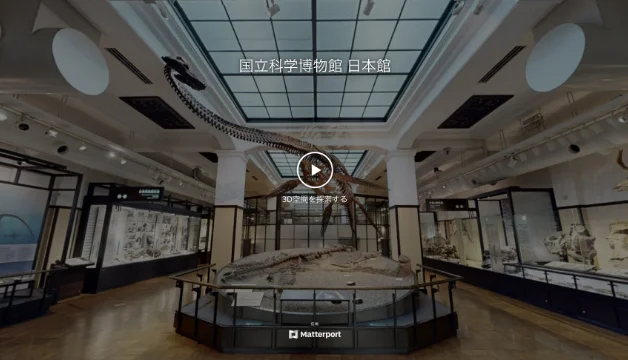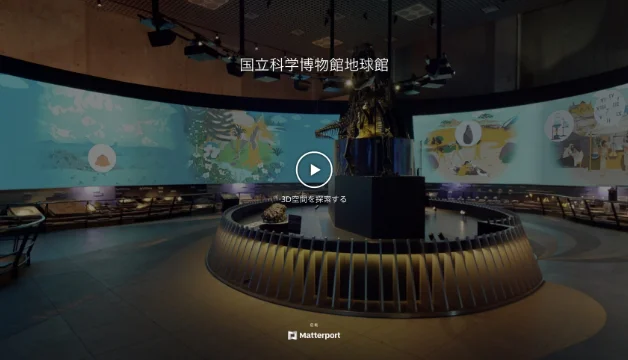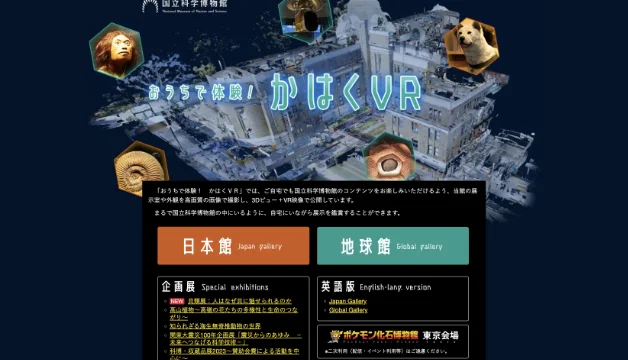Floor Map
Entrance
Explore the Museum with Kahaku VR
The National Museum of Nature and Science's “Kahaku VR” is an online experience that lets you enjoy the museum's exhibits from home. High-resolution images capture the museum's exhibition halls and exterior, presented through 3D views and VR footage. It offers an immersive experience, as if you were actually inside the museum.
Japan Gallery (Permanent Exhibitions)
 (リンクを新しいタブで開きます)
(リンクを新しいタブで開きます)
Global gallery(Permanent Exhibitions)
 (リンクを新しいタブで開きます)
(リンクを新しいタブで開きます)
Special Exhibitions
 (リンクを新しいタブで開きます)
(リンクを新しいタブで開きます)
Floor MAP
Japan Gallery Floor Maps
Toilets
Toilets
Accessible toilets/Baby changing stations
Nons Ostmate toilets
Drinking fountain
Elevator *Accesible
Ostmate toilets
North
History of the Japanese Islands
A Plesiosaur: Futabasaurus
1.The Geological Framework
of the Japanese Islands
①Continental fragment in the Japanese islands
②Rock species in accretionarycomplex
2.Before Formation of
the Japanese Archipelago
③The oldest-known fossil in Japan
④Flourishing coral sea
⑤Brachiopods' paradise
⑥Paleozoic vegetation
⑦An early ichthyosaur: Utatsusaurus
⑧Using fossils to date layers of rock
⑨Mesozoic vegetation
⑩Garden of crinoids
⑪The first dinosaur discovered in Japan
⑫Reef of konbostrea
⑬Sea of ammonites
⑭An enigmatic fossil - plant or
animal trace?
3.Opening of the Sea of Japan and
Formation of the Japanese Archipelago
⑮Forest of Japanese coal age
⑯Before the opening of the sea of Japan
⑰Opening of the sea of Japan / sea of Vicarya
4.Glacial and Interglacial Ages
⑱Metasequoia forest
⑲When elephants thrived in Japan
5.Topic Presentations
⑳Fossil chemosynthetic assemblages
㉑Fossils of deep sea organisms
South
Nature of the Japanese Islands
1.Nature of the Japanese Islands from North to South
①Nature and seasons of the Japanese islands
②Subtropical zone
③Warm temperate zone
④Cool temperate zone
⑤Subarctic zone
⑥Japanese mosses, lichens, fungi,
slime molds and freshwater fishes
2.Japan's Bountiful Seas
⑦Features of the seas around Japan
⑧Kuroshio current (temperate zone)
⑨Kuroshio current (subtropical zone)
⑩The Japan sea
⑪Oyashio current (subarctic zone)
3.Active Japanese Islands
⑫Geology of the Japanese islands
⑬Plate motion around the Japanese islands
⑭Minerals in Japan
⑮Meteorites fallen in Japan
North
Japanese People and Nature
1.A Journey of the Japanese
①The historical voyage of
the Japanese people
2.The Beginnings of Human
History in the Japanese Islands:
Our Late Paleolithic Ancestors
3.Hunter-gatherers in the Archipelago:
the Life Skills of the Jomon People
②Reading the bones:
what sort of people were the Jomon?
③Jomon lifestyles
4.Yayoi People from the Continent
and the New Development of
Wet Rice Farming
④Reading the bones:
what sort of people were the Yayoi?
⑤Yayoi lifestyles
5.The Formation of the Modern Japanese
⑥Changes in regional populations
⑦The Ryukyuans, the mainland Japanese and the Ainu
6.The Lifestyles and Health of
Our Ancestors as seen from Bones
⑧Stories from bones
⑨Recent ancestors
7.Organisms Surrounding the ⑩Japanese Influences on the nature
⑪Organisms brought into Japan
⑫Endangered organisms
⑬The organisms bred by the Japanese
8.The Natural Environment
Supporting the Japanese
⑭The diversity of rice
⑮Environmental changes associated
with rice cultivation
⑯Rice and the development
of technology
South
Organisms of the Japanese Islands
1.Evidence of Migration
and Speciation
①The history of organisms, revealed by DNA
②Changes revealed by the shapes of birds
③Marine animals of tropical/subtropical origin
2.Plant's Adaptive Strategies
for Survival
④Plants and geological history
⑤Alpine plants: survivors of the Ice ages
⑥Plants distributed in unique areas
3.Animals Separated by the Sea
⑦How islands' history is indicated by vertebrates
⑧Native land snails of the Nansei islands
⑨Speciation mechanisms in insects
⑩Blakiston line and birds
⑪Organisms of the Ogasawara islands
4.Adaptation to the Climate
⑫Larger in the north, smaller in the south
⑬Living with snow
North
Exhibition Hall for temporally exhibition
Central Hall
It is a soaring lobby which has a vaulted ceiling
with beautiful stained glasses,
Neo-Renaissance architecture
that allows you to rest in comfort
South
Techniques in Observing Nature
1.Astronomical Observation : Astronomy / Celestial Globe
①Japanese calendars
②Celestial and terrestrial globes in Edo period
③What we have observed with telescopes
2.Earthquake Measurement : Seismograph
④To read motion of the ground
⑤Development of seismographs
⑥Evolving seismographs
3.To Measure Time: Clocks and Watches
⑦Temporal hours and the Japanese clock, Wadokei
⑧Modernization of clock industry
4.Tiny Miracles: Microscopes
⑨Scientific ideas inspired by curiosity
⑩Challenging the minimum:ultramicroscopes
Global Gallery Floor Maps
Toilets
Toilets
Accessible toilets/Baby changing stations
Nursing room
Drinking fountain
Elevator *Accesible
Ostomate toilets
Rooftop
Sky Deck
Herb Garden
ComPaSS - Exploration Area for Families with Children
Animals of the Earth
1.Peak of Evolution : Large Wild Mammals
①Peak of evolution : large wild mammals
2.Way of Survival
②Way of survival
3.Mammals in Savanna
③Mammals in savanna
4.Our Evolutionary Kindred
④Our evolutionary kindred
5.On the Brink of Extinction
⑤On the brink of extinction
6.Birds of Diverse Appearances
⑥Birds of diverse appearances
Investigation Technology for the Earth
A.GED
(Global Environmental Detector)
ⓐGED
(Global environmental detector)
B.The Science to Investigate the Earth
ⓑInvestigate the ground
©Investigate interior of the earth
Progress in Science and Technology Investigation Technology for the Earth
1.Introduction to the History of Science and Technology
①Introduction to the history of science and technology
2.Science and Technology in the Edo Period
②Mining in the Edo period
③Development and popularization
of arithmetic
④Astronomy and surveying
⑤Transition from herbalism to natural history
⑥Medicine in the Edo period
⑦Skills of the masters
3.The Beginning of Modernization
⑧Standardization of criteria and systems
⑨Cultivating human resources for modernization
⑩Spread of modern science and technology
⑪Introduction of machine tools
⑫Introduction of electrical power systems
4.Results of Modernization
⑬Inventions and creations by Japanese people
⑭Birth of the car manufacturing industry
⑮Development of aviation technology
⑯New technology: picture transmission
5.Further Developments in
Japanese Science and Technology
⑰Mechanical calculators
⑱Computers
⑲Space development in Japan
6.Past, Present, and Future
of Science and Technology
⑳Past, present, and future of
science and technology
Great Japanese Figures in Science and Technology
This exhibit can be easily accessed by stairs located in front of the Information Desk on the 1st floor or by escalator from the 2nd floor.
Navigators on History of Earth Biodiversity
1.Navigators on History of Earth
①All comprise atoms
②History of the universe
③History of life
④History of humankind
⑤Time line stage
Biodiversity
1.Diversity of Marine Life
⑥Photosynthetic ecosystem
⑦Chemical synthetic ecosystem
2.Diversity of Terrestrial Life
⑧Various landscapes on earth
⑨The linkage of life
⑩Mangrove forests
⑪Tropical rainforests
⑫Wetlands
⑬Temperate forests
⑭Alpine regions
⑮Deserts
3.Origins of Biodiversity
⑯What is life?
⑰Species of life
⑱Factors of diversification : evolution
⑲Factors of diversification : speciation
⑳Examples of diversification
4.Tree of Life
㉑Tree of life
5.Strategies for Survival : Adaptation
㉒Size factors
㉓Challenges of extreme
temperature and humidity
㉔Seeking for nutrients
㉕Succession of life
㉖Symbiosis and parasitism
6.Conservation of Biodiversity
㉗How much do we really know?
㉘Pursuit of biodiversity
㉙Red list
㉚Inter-specific network around
Japanese crested Ibis
㉛Recovery of endangered species
㉜Networks on conservation of
biodiversity
Evolution of Life ─Exploring the Mysteries of Dinosaur Evolution ─
1.Exploring the Mysteries of
Dinosaur Evolution
①Evolution of saurischian dinosaurs
②Evolution of ornithischian dinosaurs
③The last day of the Mesozoic
The Special Exhibition Hall
Evolution of Life ─From the Earth's Origin through Human Existence─
1.A Stroll Through 4.6 Billion Years of History
①Astroll through 4.6 billion years of history
2.Geological Samples from the Planet Earth
②Rocks and minerals
③Fossils
3.Biotic Response to Global
Environmental Change
④Records of global environmental change
⑤Mass extinctions
⑥Geosphere-biosphere interactions
⑦Microfossils
Explosive evolution of
life in the sea
⑧Precambrian microorganisms
⑨Vendian life
⑩Strange animals in Burgess
Shale and Chengjang Faunas
⑪Paleozoic invertebrates
⑫Trilobites in the paleozoic sea
⑬Evolution and success of fishes
5.Plants and Anima
⑭First steps on the land
⑮Greening the land
6.The Age of Mammals
⑯Origin of the mammals
⑰Mesozoic mammals
⑱Early mammals lived in forests
⑲Early mammals lived in grasslands and arid lands
⑳Mammals of island continents
㉑Graviportal mammals
㉒Carnivorous mammals
7.Secondary adaptation of tetrapods to life in water.
㉓Secondary adaptation of tetrapods to life in water
㉔The forerunners of aquatic ammals
㉕Convergence to life in water
㉖A pioneer in new food resources.
㉗A gigantic marine reptile
㉘Diving birds
8.Flying tetrapods
㉙Flying tetrapods
9.Human Evolution
㉚Primate evolution
㉛The evolution of the Australopithecines
and contemporary species
㉜The evolution of early Homo
㉝Reconstructing ancient humans
The evolution and worldwide
expansion of modern humans
㉞The expansion of modern humans:
out of Africa again
㉟The expansion of modern humans:
into Eurasia
㊱The expansion of modern humans:
into Oceania
㊲The expansion of modern humans:
into northern Eurasia
㊳The expansion of modern humans:
Into the Americas
Exploring the Structure of Nature
0.Japanese Scientists
ⓐJapanese Nobel Prize laureates in
physics, chemistry, and physiology or medicine
ⓑJapanese builders of science with
items from our collection
1.Exploring the Laws of Nature
⓪Exploring the world of elementary particles KEKB accelerator & Belle experiment
①Measurements
②Measuring electricity and magnetism
③Measuring temperature
④Thermal radiation and energy
⑤Speed of light
⑥Gravity
2.Exploring the Universe
⑦Telescopes: our eyes to investigate the universe
⑧Let's take a look at celestial bodies
⑨Hierarchical structure of the universe
⑩The solar system
⑪Fixed stars, nebulae, and star clusters
⑫Galaxies and clusters of galaxies
⑬Superclusters of galaxies and the large-scale structure of the universe
⑭The expansion of the universe and its origin
3.Exploring the World of Matter
⑮Hierarchical structure of matter
⑯Periodic table: the diversity of elements
⑰Shape of molecules: a variety of matter
⑱Exploring the nanoworld
⑲Exploring the ultimate formation of matter
⑳Macroscopic properties and microscopic properties
㉑Functional materials
㉒Striving for environmentally friendly chemist